Unfair Dismissal Claim under Fair Work Act 2009
VerifiedAdded on 2023/06/11
|7
|2370
|228
AI Summary
This article discusses the provisions related to unfair dismissal claim under Fair Work Act 2009 and the remedies available. It explains the criteria for determining whether dismissal is harsh or unjust and provides a case analysis on Lando's right to file an unfair dismissal claim against his employer.
Contribute Materials
Your contribution can guide someone’s learning journey. Share your
documents today.
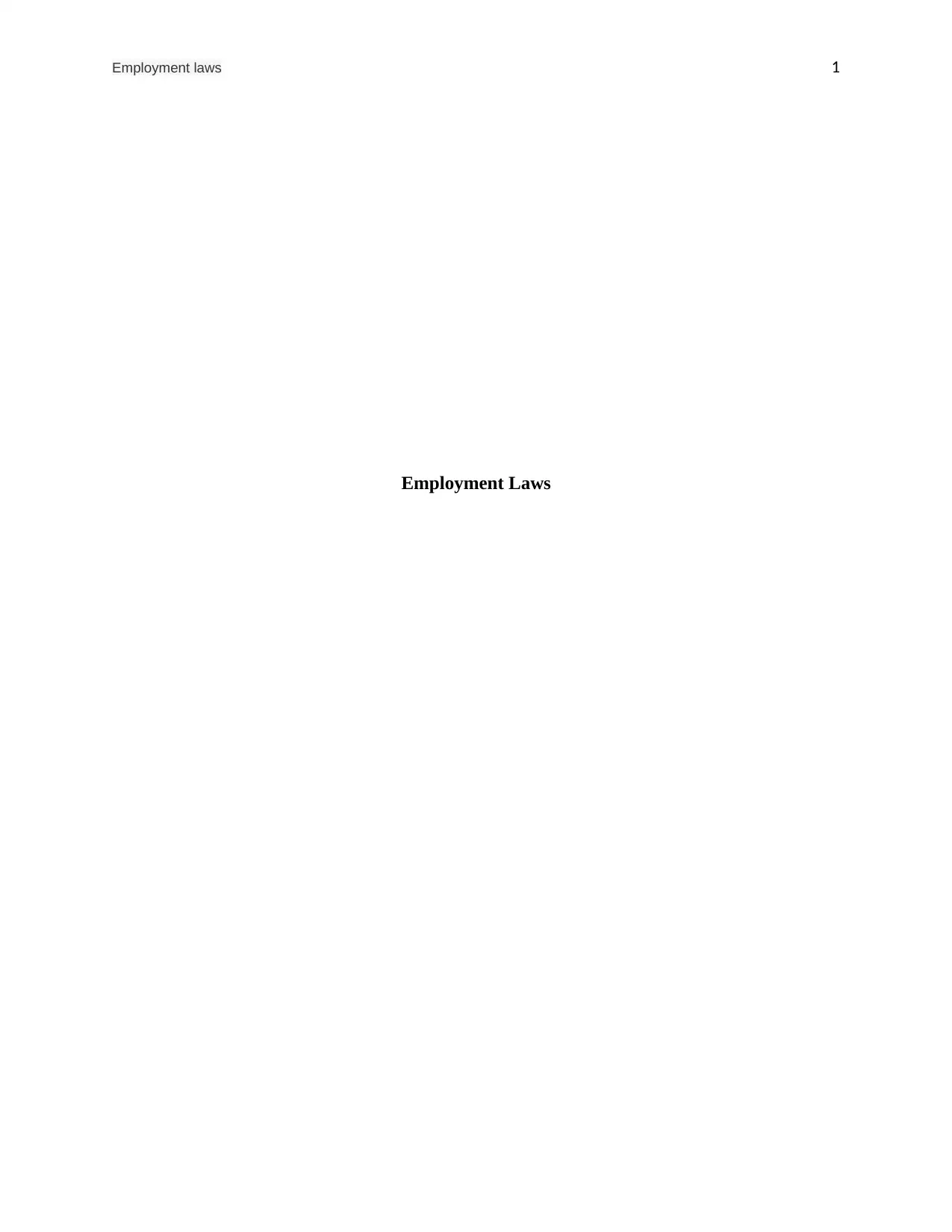
Employment laws 1
Employment Laws
Employment Laws
Secure Best Marks with AI Grader
Need help grading? Try our AI Grader for instant feedback on your assignments.

Employment laws 2
Answer 1
Part B
Issue:
Whether Lando has right to file claim of unfair dismissal under the fair Work Act 2009, and the
orders which can be made by the Court if case is upheld?
Law:
In case person is unfairly dismissed or dismissed by the employer, or such person is forced to
resign because of the pressure imposed by employer on the employee, then such person has right
to make application to the Fair Work Commission (FWC) for seeking the reinstatement or
compensation. This claim is known as the unfair dismissal claim. Dismissal of the person is
considered as the unfair dismissal if such person:
Dismissed by the employer.
Dismissed because of any harsh, unjust, or unreasonable reason.
Dismissal was not the case of the actual redundancy1.
Section 385 of the Fair Work Act 2009 states the provisions related to the unfair dismissal. As
per this section, dismissal is considered as the unfair dismissal if FWC is satisfied:
Person is dismissed by the employer.
Dismissal is done because of any harsh, unjust, or unreasonable reason.
Dismissal was not the case of the actual redundancy2
Section 3863 of the Act states the meaning of the dismissal and as per this section person is
considered as dismissed person if the employer terminates the person from his employment or
person is resigned from the employment because of pressure of employer. This can be
understood through case law Gerrard v UPS Pty Ltd unreported, Eames C, 19 March 2004,
PR9446814; Allan West v Holcim (Australia) Pty Ltd. [2017] FWC 2346. (U2016/14182).5
Section 387 6of the Act defines the criteria of determining whether reason is harsh or unjust. As
per this section, for the purpose of considering whether dismissal of the employee is harsh and
unjust, following factors are considered by the FWC:
1 FWC, 2018, Unfair dismissal – Am I eligible to apply?, <
https://www.fwc.gov.au/termination-of-employment/unfair-dismissal/eligibility>, accessed on 17th June 2018.
2 Fair Work Act 2009- Section 385.
3 Fair Work Act 2009- Section 386.
4 Gerrard v UPS Pty Ltd unreported, Eames C, 19 March 2004, PR944681.
5 Allan West v Holcim (Australia) Pty Ltd. [2017] FWC 2346. (U2016/14182).
6 Fair Work Act 2009- Section 387
Answer 1
Part B
Issue:
Whether Lando has right to file claim of unfair dismissal under the fair Work Act 2009, and the
orders which can be made by the Court if case is upheld?
Law:
In case person is unfairly dismissed or dismissed by the employer, or such person is forced to
resign because of the pressure imposed by employer on the employee, then such person has right
to make application to the Fair Work Commission (FWC) for seeking the reinstatement or
compensation. This claim is known as the unfair dismissal claim. Dismissal of the person is
considered as the unfair dismissal if such person:
Dismissed by the employer.
Dismissed because of any harsh, unjust, or unreasonable reason.
Dismissal was not the case of the actual redundancy1.
Section 385 of the Fair Work Act 2009 states the provisions related to the unfair dismissal. As
per this section, dismissal is considered as the unfair dismissal if FWC is satisfied:
Person is dismissed by the employer.
Dismissal is done because of any harsh, unjust, or unreasonable reason.
Dismissal was not the case of the actual redundancy2
Section 3863 of the Act states the meaning of the dismissal and as per this section person is
considered as dismissed person if the employer terminates the person from his employment or
person is resigned from the employment because of pressure of employer. This can be
understood through case law Gerrard v UPS Pty Ltd unreported, Eames C, 19 March 2004,
PR9446814; Allan West v Holcim (Australia) Pty Ltd. [2017] FWC 2346. (U2016/14182).5
Section 387 6of the Act defines the criteria of determining whether reason is harsh or unjust. As
per this section, for the purpose of considering whether dismissal of the employee is harsh and
unjust, following factors are considered by the FWC:
1 FWC, 2018, Unfair dismissal – Am I eligible to apply?, <
https://www.fwc.gov.au/termination-of-employment/unfair-dismissal/eligibility>, accessed on 17th June 2018.
2 Fair Work Act 2009- Section 385.
3 Fair Work Act 2009- Section 386.
4 Gerrard v UPS Pty Ltd unreported, Eames C, 19 March 2004, PR944681.
5 Allan West v Holcim (Australia) Pty Ltd. [2017] FWC 2346. (U2016/14182).
6 Fair Work Act 2009- Section 387
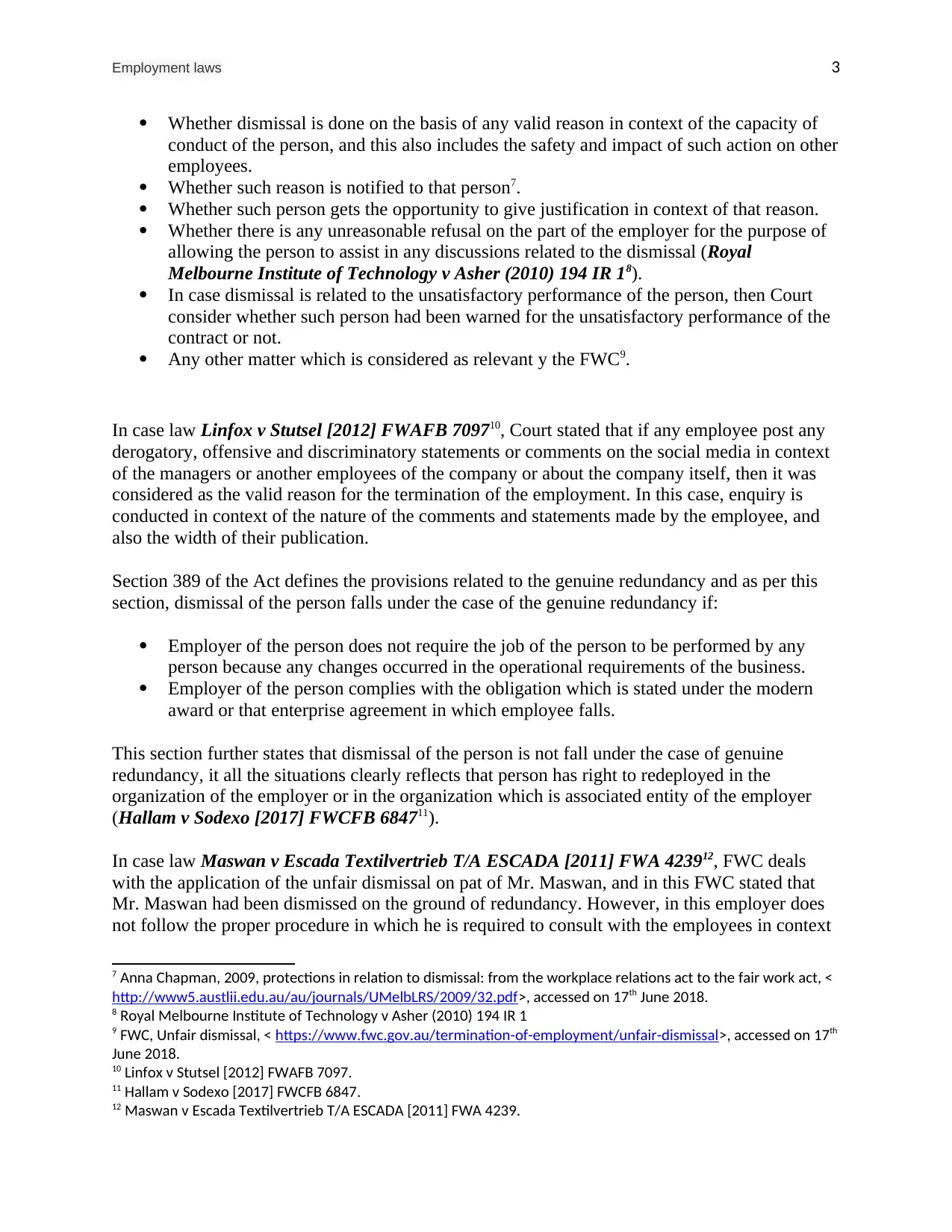
Employment laws 3
Whether dismissal is done on the basis of any valid reason in context of the capacity of
conduct of the person, and this also includes the safety and impact of such action on other
employees.
Whether such reason is notified to that person7.
Whether such person gets the opportunity to give justification in context of that reason.
Whether there is any unreasonable refusal on the part of the employer for the purpose of
allowing the person to assist in any discussions related to the dismissal (Royal
Melbourne Institute of Technology v Asher (2010) 194 IR 18).
In case dismissal is related to the unsatisfactory performance of the person, then Court
consider whether such person had been warned for the unsatisfactory performance of the
contract or not.
Any other matter which is considered as relevant y the FWC9.
In case law Linfox v Stutsel [2012] FWAFB 709710, Court stated that if any employee post any
derogatory, offensive and discriminatory statements or comments on the social media in context
of the managers or another employees of the company or about the company itself, then it was
considered as the valid reason for the termination of the employment. In this case, enquiry is
conducted in context of the nature of the comments and statements made by the employee, and
also the width of their publication.
Section 389 of the Act defines the provisions related to the genuine redundancy and as per this
section, dismissal of the person falls under the case of the genuine redundancy if:
Employer of the person does not require the job of the person to be performed by any
person because any changes occurred in the operational requirements of the business.
Employer of the person complies with the obligation which is stated under the modern
award or that enterprise agreement in which employee falls.
This section further states that dismissal of the person is not fall under the case of genuine
redundancy, it all the situations clearly reflects that person has right to redeployed in the
organization of the employer or in the organization which is associated entity of the employer
(Hallam v Sodexo [2017] FWCFB 684711).
In case law Maswan v Escada Textilvertrieb T/A ESCADA [2011] FWA 423912, FWC deals
with the application of the unfair dismissal on pat of Mr. Maswan, and in this FWC stated that
Mr. Maswan had been dismissed on the ground of redundancy. However, in this employer does
not follow the proper procedure in which he is required to consult with the employees in context
7 Anna Chapman, 2009, protections in relation to dismissal: from the workplace relations act to the fair work act, <
http://www5.austlii.edu.au/au/journals/UMelbLRS/2009/32.pdf>, accessed on 17th June 2018.
8 Royal Melbourne Institute of Technology v Asher (2010) 194 IR 1
9 FWC, Unfair dismissal, < https://www.fwc.gov.au/termination-of-employment/unfair-dismissal>, accessed on 17th
June 2018.
10 Linfox v Stutsel [2012] FWAFB 7097.
11 Hallam v Sodexo [2017] FWCFB 6847.
12 Maswan v Escada Textilvertrieb T/A ESCADA [2011] FWA 4239.
Whether dismissal is done on the basis of any valid reason in context of the capacity of
conduct of the person, and this also includes the safety and impact of such action on other
employees.
Whether such reason is notified to that person7.
Whether such person gets the opportunity to give justification in context of that reason.
Whether there is any unreasonable refusal on the part of the employer for the purpose of
allowing the person to assist in any discussions related to the dismissal (Royal
Melbourne Institute of Technology v Asher (2010) 194 IR 18).
In case dismissal is related to the unsatisfactory performance of the person, then Court
consider whether such person had been warned for the unsatisfactory performance of the
contract or not.
Any other matter which is considered as relevant y the FWC9.
In case law Linfox v Stutsel [2012] FWAFB 709710, Court stated that if any employee post any
derogatory, offensive and discriminatory statements or comments on the social media in context
of the managers or another employees of the company or about the company itself, then it was
considered as the valid reason for the termination of the employment. In this case, enquiry is
conducted in context of the nature of the comments and statements made by the employee, and
also the width of their publication.
Section 389 of the Act defines the provisions related to the genuine redundancy and as per this
section, dismissal of the person falls under the case of the genuine redundancy if:
Employer of the person does not require the job of the person to be performed by any
person because any changes occurred in the operational requirements of the business.
Employer of the person complies with the obligation which is stated under the modern
award or that enterprise agreement in which employee falls.
This section further states that dismissal of the person is not fall under the case of genuine
redundancy, it all the situations clearly reflects that person has right to redeployed in the
organization of the employer or in the organization which is associated entity of the employer
(Hallam v Sodexo [2017] FWCFB 684711).
In case law Maswan v Escada Textilvertrieb T/A ESCADA [2011] FWA 423912, FWC deals
with the application of the unfair dismissal on pat of Mr. Maswan, and in this FWC stated that
Mr. Maswan had been dismissed on the ground of redundancy. However, in this employer does
not follow the proper procedure in which he is required to consult with the employees in context
7 Anna Chapman, 2009, protections in relation to dismissal: from the workplace relations act to the fair work act, <
http://www5.austlii.edu.au/au/journals/UMelbLRS/2009/32.pdf>, accessed on 17th June 2018.
8 Royal Melbourne Institute of Technology v Asher (2010) 194 IR 1
9 FWC, Unfair dismissal, < https://www.fwc.gov.au/termination-of-employment/unfair-dismissal>, accessed on 17th
June 2018.
10 Linfox v Stutsel [2012] FWAFB 7097.
11 Hallam v Sodexo [2017] FWCFB 6847.
12 Maswan v Escada Textilvertrieb T/A ESCADA [2011] FWA 4239.
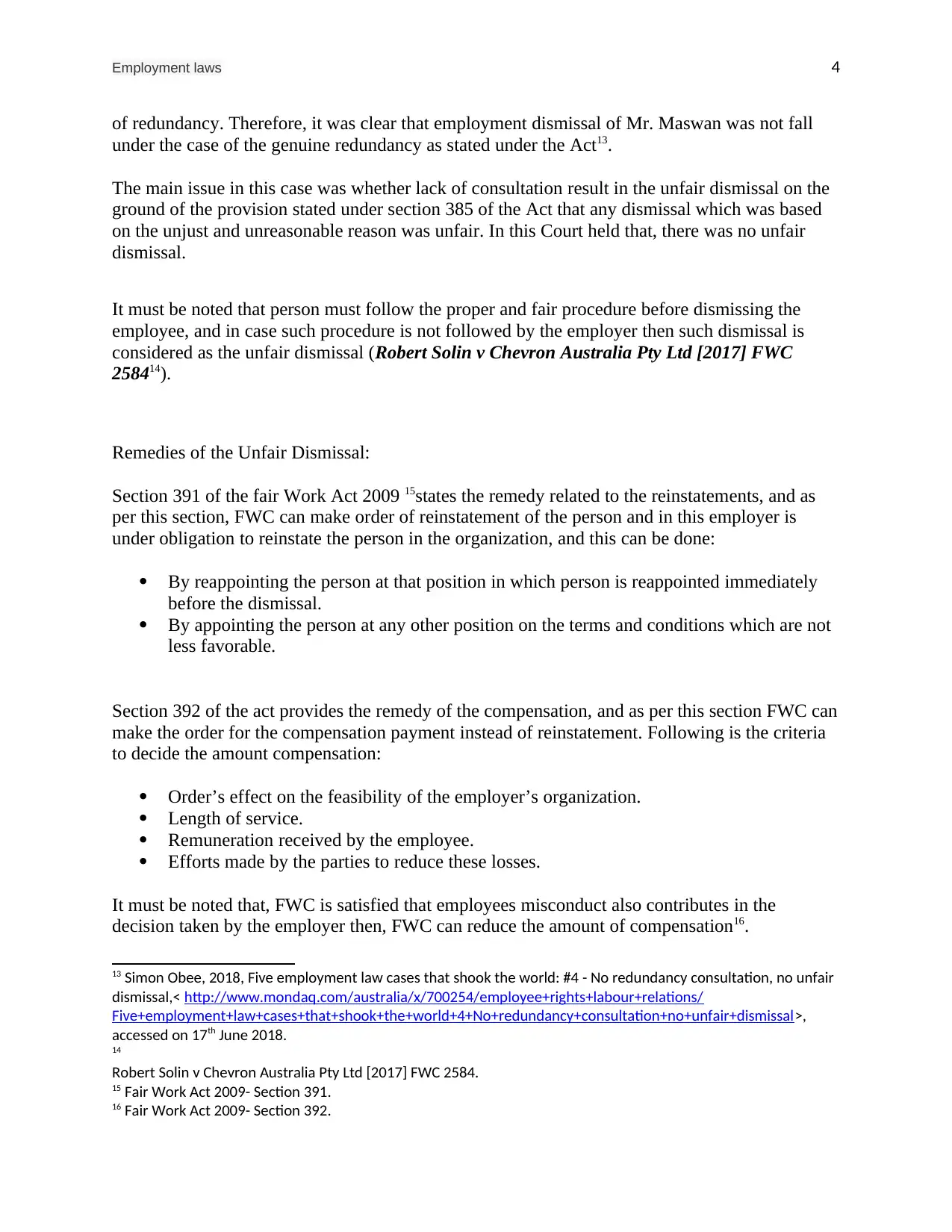
Employment laws 4
of redundancy. Therefore, it was clear that employment dismissal of Mr. Maswan was not fall
under the case of the genuine redundancy as stated under the Act13.
The main issue in this case was whether lack of consultation result in the unfair dismissal on the
ground of the provision stated under section 385 of the Act that any dismissal which was based
on the unjust and unreasonable reason was unfair. In this Court held that, there was no unfair
dismissal.
It must be noted that person must follow the proper and fair procedure before dismissing the
employee, and in case such procedure is not followed by the employer then such dismissal is
considered as the unfair dismissal (Robert Solin v Chevron Australia Pty Ltd [2017] FWC
258414).
Remedies of the Unfair Dismissal:
Section 391 of the fair Work Act 2009 15states the remedy related to the reinstatements, and as
per this section, FWC can make order of reinstatement of the person and in this employer is
under obligation to reinstate the person in the organization, and this can be done:
By reappointing the person at that position in which person is reappointed immediately
before the dismissal.
By appointing the person at any other position on the terms and conditions which are not
less favorable.
Section 392 of the act provides the remedy of the compensation, and as per this section FWC can
make the order for the compensation payment instead of reinstatement. Following is the criteria
to decide the amount compensation:
Order’s effect on the feasibility of the employer’s organization.
Length of service.
Remuneration received by the employee.
Efforts made by the parties to reduce these losses.
It must be noted that, FWC is satisfied that employees misconduct also contributes in the
decision taken by the employer then, FWC can reduce the amount of compensation16.
13 Simon Obee, 2018, Five employment law cases that shook the world: #4 - No redundancy consultation, no unfair
dismissal,< http://www.mondaq.com/australia/x/700254/employee+rights+labour+relations/
Five+employment+law+cases+that+shook+the+world+4+No+redundancy+consultation+no+unfair+dismissal>,
accessed on 17th June 2018.
14
Robert Solin v Chevron Australia Pty Ltd [2017] FWC 2584.
15 Fair Work Act 2009- Section 391.
16 Fair Work Act 2009- Section 392.
of redundancy. Therefore, it was clear that employment dismissal of Mr. Maswan was not fall
under the case of the genuine redundancy as stated under the Act13.
The main issue in this case was whether lack of consultation result in the unfair dismissal on the
ground of the provision stated under section 385 of the Act that any dismissal which was based
on the unjust and unreasonable reason was unfair. In this Court held that, there was no unfair
dismissal.
It must be noted that person must follow the proper and fair procedure before dismissing the
employee, and in case such procedure is not followed by the employer then such dismissal is
considered as the unfair dismissal (Robert Solin v Chevron Australia Pty Ltd [2017] FWC
258414).
Remedies of the Unfair Dismissal:
Section 391 of the fair Work Act 2009 15states the remedy related to the reinstatements, and as
per this section, FWC can make order of reinstatement of the person and in this employer is
under obligation to reinstate the person in the organization, and this can be done:
By reappointing the person at that position in which person is reappointed immediately
before the dismissal.
By appointing the person at any other position on the terms and conditions which are not
less favorable.
Section 392 of the act provides the remedy of the compensation, and as per this section FWC can
make the order for the compensation payment instead of reinstatement. Following is the criteria
to decide the amount compensation:
Order’s effect on the feasibility of the employer’s organization.
Length of service.
Remuneration received by the employee.
Efforts made by the parties to reduce these losses.
It must be noted that, FWC is satisfied that employees misconduct also contributes in the
decision taken by the employer then, FWC can reduce the amount of compensation16.
13 Simon Obee, 2018, Five employment law cases that shook the world: #4 - No redundancy consultation, no unfair
dismissal,< http://www.mondaq.com/australia/x/700254/employee+rights+labour+relations/
Five+employment+law+cases+that+shook+the+world+4+No+redundancy+consultation+no+unfair+dismissal>,
accessed on 17th June 2018.
14
Robert Solin v Chevron Australia Pty Ltd [2017] FWC 2584.
15 Fair Work Act 2009- Section 391.
16 Fair Work Act 2009- Section 392.
Secure Best Marks with AI Grader
Need help grading? Try our AI Grader for instant feedback on your assignments.

Employment laws 5
Application:
In the present case, Lando sign employment agreement with the organization in which following
provisions are present:
Employer terminates the employee before the completion of the employment period.
Termination is based on the massive misconduct on the part of the employee and no
sufficient time is provided to justify the cause.
Termination is done without providing notice or provides notice for insufficient time
period.
It must be noted that both the parties’ sign the contract with each other, and this document is
considered as the solid proof of existence of employment. In this case, Lando breach the terms of
the agreement and such breach are serious in nature, as Lando involve in the willful misconduct
as he personally responded on the Jayed’s compliant and this affects the reputation of the
company in negative manner. In case law Linfox v Stutsel [2012] FWAFB 7097, Court stated
that if any employee post any derogatory, offensive and discriminatory statements or comments
on the social media in context of the managers or another employees of the company or about the
company itself, then it was considered as the valid reason for the termination of the employment.
Lando also said while providing interview to the Fitness, that he has strong client base and such
client base is actually the property of the Fitworld which cannot be used by the Lando for his
own use. Both the reasons give important contribution in the dismissal decision of the employer.
While dismissing the employee employer provides this reason as the ground.
In this, lando involves in the serious misconduct and breach the provisions of the contract with
the company. Therefore, in this Section 385 is applied which stated person is dismissed by the
employer, and this dismissal is not done because of any harsh, unjust, or unreasonable reason.
However, it must be noted that employer further stated that this dismissal was also done because
of the genuine redundancy, but in actual this is not the seen. As stated by section 389 of the Act,
if employer of the person does not require the job of the person to be performed by any person
because any changes occurred in the operational requirements of the business, and employer of
the person complies with the obligation which is stated under the modern award or that
enterprise agreement in which employee falls. In this case, both the situations are not satisfied
because all other employees of the company are already transferred. FitWorld also failed to
consult the matter of the redundancy with the Lando.
As stated above, Employer must follow the proper and fair procedure before dismissing the
employee, and in case such procedure is not followed by the employer then such dismissal is
considered as the unfair dismissal. In the present case, Employer fails to follow the proper
procedure before dismissing the employee such as no opportunity is giving to the Lando to
present his position and this clearly makes the dismissal unfair dismissal. Therefore, lando has
right to file claim against the Employer for Unfair dismissal under the Fair Work Act 2009.
Application:
In the present case, Lando sign employment agreement with the organization in which following
provisions are present:
Employer terminates the employee before the completion of the employment period.
Termination is based on the massive misconduct on the part of the employee and no
sufficient time is provided to justify the cause.
Termination is done without providing notice or provides notice for insufficient time
period.
It must be noted that both the parties’ sign the contract with each other, and this document is
considered as the solid proof of existence of employment. In this case, Lando breach the terms of
the agreement and such breach are serious in nature, as Lando involve in the willful misconduct
as he personally responded on the Jayed’s compliant and this affects the reputation of the
company in negative manner. In case law Linfox v Stutsel [2012] FWAFB 7097, Court stated
that if any employee post any derogatory, offensive and discriminatory statements or comments
on the social media in context of the managers or another employees of the company or about the
company itself, then it was considered as the valid reason for the termination of the employment.
Lando also said while providing interview to the Fitness, that he has strong client base and such
client base is actually the property of the Fitworld which cannot be used by the Lando for his
own use. Both the reasons give important contribution in the dismissal decision of the employer.
While dismissing the employee employer provides this reason as the ground.
In this, lando involves in the serious misconduct and breach the provisions of the contract with
the company. Therefore, in this Section 385 is applied which stated person is dismissed by the
employer, and this dismissal is not done because of any harsh, unjust, or unreasonable reason.
However, it must be noted that employer further stated that this dismissal was also done because
of the genuine redundancy, but in actual this is not the seen. As stated by section 389 of the Act,
if employer of the person does not require the job of the person to be performed by any person
because any changes occurred in the operational requirements of the business, and employer of
the person complies with the obligation which is stated under the modern award or that
enterprise agreement in which employee falls. In this case, both the situations are not satisfied
because all other employees of the company are already transferred. FitWorld also failed to
consult the matter of the redundancy with the Lando.
As stated above, Employer must follow the proper and fair procedure before dismissing the
employee, and in case such procedure is not followed by the employer then such dismissal is
considered as the unfair dismissal. In the present case, Employer fails to follow the proper
procedure before dismissing the employee such as no opportunity is giving to the Lando to
present his position and this clearly makes the dismissal unfair dismissal. Therefore, lando has
right to file claim against the Employer for Unfair dismissal under the Fair Work Act 2009.
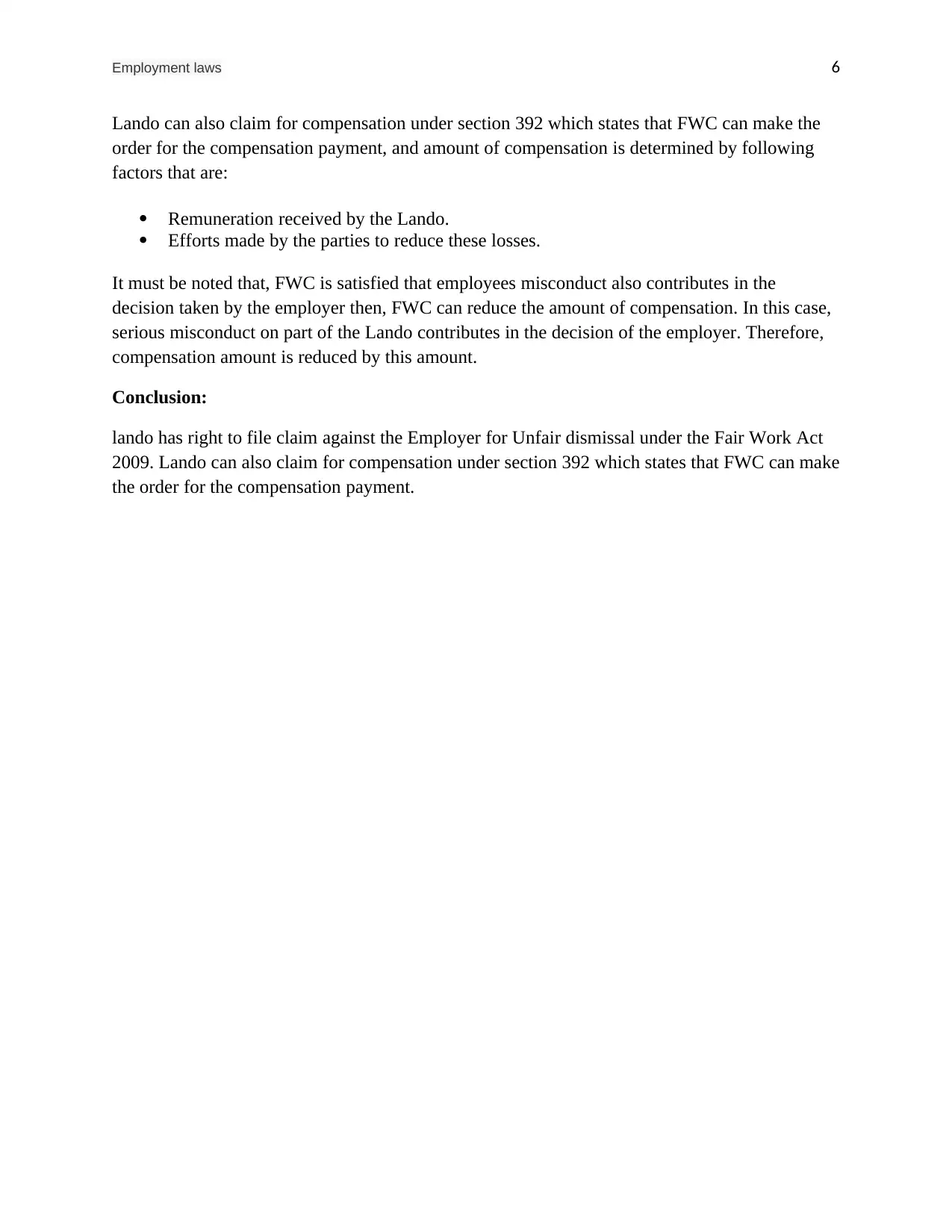
Employment laws 6
Lando can also claim for compensation under section 392 which states that FWC can make the
order for the compensation payment, and amount of compensation is determined by following
factors that are:
Remuneration received by the Lando.
Efforts made by the parties to reduce these losses.
It must be noted that, FWC is satisfied that employees misconduct also contributes in the
decision taken by the employer then, FWC can reduce the amount of compensation. In this case,
serious misconduct on part of the Lando contributes in the decision of the employer. Therefore,
compensation amount is reduced by this amount.
Conclusion:
lando has right to file claim against the Employer for Unfair dismissal under the Fair Work Act
2009. Lando can also claim for compensation under section 392 which states that FWC can make
the order for the compensation payment.
Lando can also claim for compensation under section 392 which states that FWC can make the
order for the compensation payment, and amount of compensation is determined by following
factors that are:
Remuneration received by the Lando.
Efforts made by the parties to reduce these losses.
It must be noted that, FWC is satisfied that employees misconduct also contributes in the
decision taken by the employer then, FWC can reduce the amount of compensation. In this case,
serious misconduct on part of the Lando contributes in the decision of the employer. Therefore,
compensation amount is reduced by this amount.
Conclusion:
lando has right to file claim against the Employer for Unfair dismissal under the Fair Work Act
2009. Lando can also claim for compensation under section 392 which states that FWC can make
the order for the compensation payment.
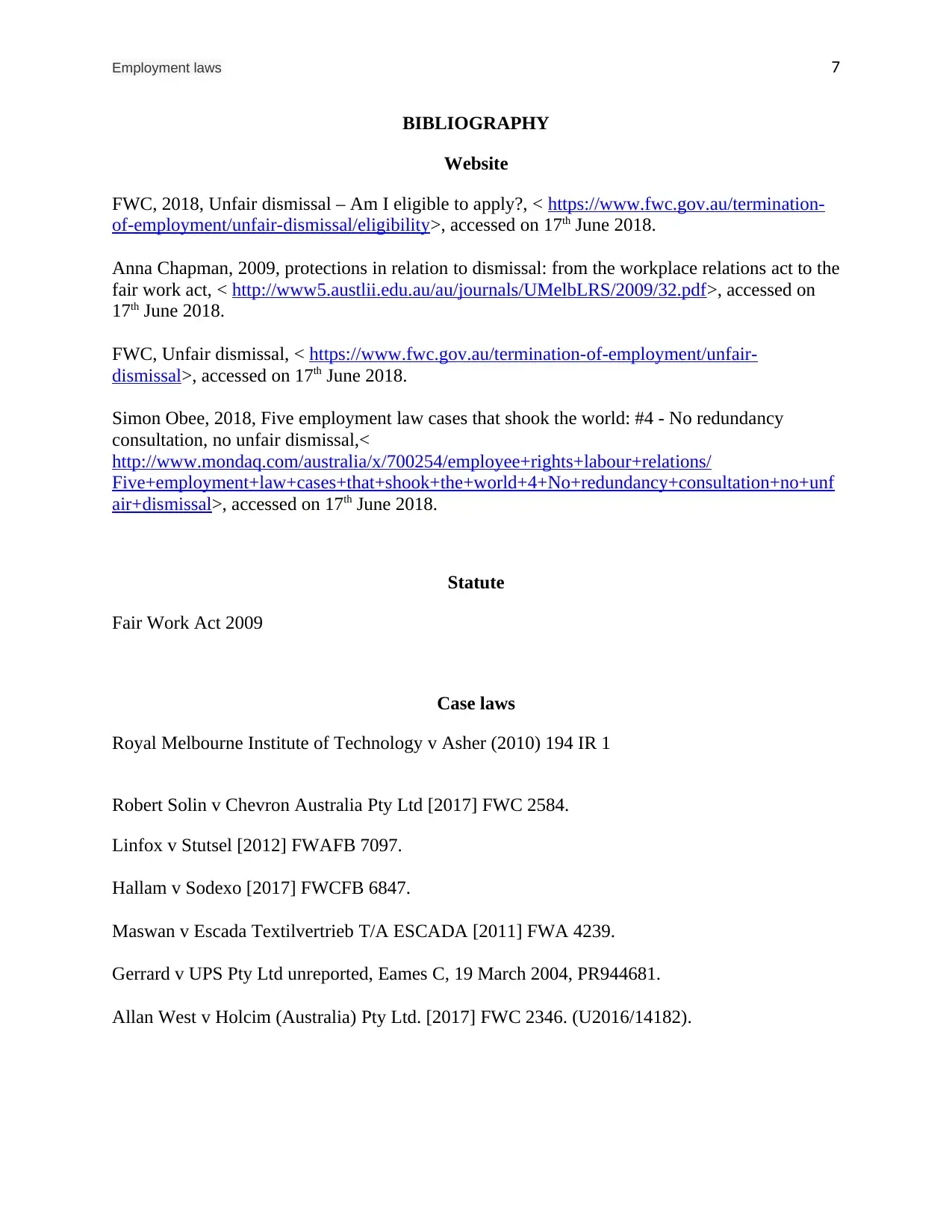
Employment laws 7
BIBLIOGRAPHY
Website
FWC, 2018, Unfair dismissal – Am I eligible to apply?, < https://www.fwc.gov.au/termination-
of-employment/unfair-dismissal/eligibility>, accessed on 17th June 2018.
Anna Chapman, 2009, protections in relation to dismissal: from the workplace relations act to the
fair work act, < http://www5.austlii.edu.au/au/journals/UMelbLRS/2009/32.pdf>, accessed on
17th June 2018.
FWC, Unfair dismissal, < https://www.fwc.gov.au/termination-of-employment/unfair-
dismissal>, accessed on 17th June 2018.
Simon Obee, 2018, Five employment law cases that shook the world: #4 - No redundancy
consultation, no unfair dismissal,<
http://www.mondaq.com/australia/x/700254/employee+rights+labour+relations/
Five+employment+law+cases+that+shook+the+world+4+No+redundancy+consultation+no+unf
air+dismissal>, accessed on 17th June 2018.
Statute
Fair Work Act 2009
Case laws
Royal Melbourne Institute of Technology v Asher (2010) 194 IR 1
Robert Solin v Chevron Australia Pty Ltd [2017] FWC 2584.
Linfox v Stutsel [2012] FWAFB 7097.
Hallam v Sodexo [2017] FWCFB 6847.
Maswan v Escada Textilvertrieb T/A ESCADA [2011] FWA 4239.
Gerrard v UPS Pty Ltd unreported, Eames C, 19 March 2004, PR944681.
Allan West v Holcim (Australia) Pty Ltd. [2017] FWC 2346. (U2016/14182).
BIBLIOGRAPHY
Website
FWC, 2018, Unfair dismissal – Am I eligible to apply?, < https://www.fwc.gov.au/termination-
of-employment/unfair-dismissal/eligibility>, accessed on 17th June 2018.
Anna Chapman, 2009, protections in relation to dismissal: from the workplace relations act to the
fair work act, < http://www5.austlii.edu.au/au/journals/UMelbLRS/2009/32.pdf>, accessed on
17th June 2018.
FWC, Unfair dismissal, < https://www.fwc.gov.au/termination-of-employment/unfair-
dismissal>, accessed on 17th June 2018.
Simon Obee, 2018, Five employment law cases that shook the world: #4 - No redundancy
consultation, no unfair dismissal,<
http://www.mondaq.com/australia/x/700254/employee+rights+labour+relations/
Five+employment+law+cases+that+shook+the+world+4+No+redundancy+consultation+no+unf
air+dismissal>, accessed on 17th June 2018.
Statute
Fair Work Act 2009
Case laws
Royal Melbourne Institute of Technology v Asher (2010) 194 IR 1
Robert Solin v Chevron Australia Pty Ltd [2017] FWC 2584.
Linfox v Stutsel [2012] FWAFB 7097.
Hallam v Sodexo [2017] FWCFB 6847.
Maswan v Escada Textilvertrieb T/A ESCADA [2011] FWA 4239.
Gerrard v UPS Pty Ltd unreported, Eames C, 19 March 2004, PR944681.
Allan West v Holcim (Australia) Pty Ltd. [2017] FWC 2346. (U2016/14182).
1 out of 7
Related Documents
Your All-in-One AI-Powered Toolkit for Academic Success.
+13062052269
info@desklib.com
Available 24*7 on WhatsApp / Email
![[object Object]](/_next/static/media/star-bottom.7253800d.svg)
Unlock your academic potential
© 2024 | Zucol Services PVT LTD | All rights reserved.




